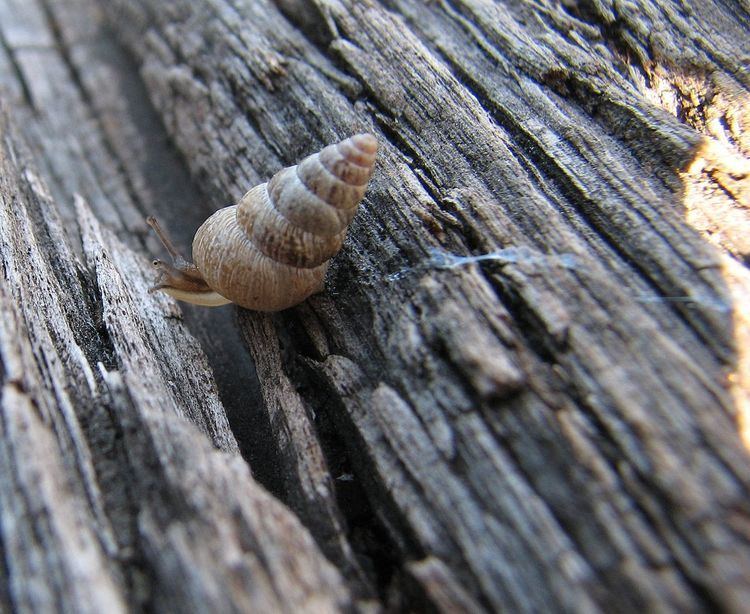 | ||
Snail slime is a kind of mucus, an external bodily secretion which is produced by snails, gastropod mollusks. Land snails and slugs produce mucus, but so does every other kind of gastropod, from marine, freshwater and terrestrial habitats. The reproductive system of gastropods also produces mucus internally from special glands.
Contents
Externally, one kind of mucus is produced by the foot of the gastropod and is usually used for crawling on. The other kind of external mucus is designed to coat the external parts of the gastropod's body; in land species this coating helps prevent desiccation of the exposed soft tissues. The foot mucus of a gastropod has some of the qualities of a glue and some of the qualities of a lubricant, allowing land snails to crawl up vertical surfaces without falling off.
The slime trail that a land gastropod leaves behind is often visible as a silvery track on surfaces such as stone or concrete.
Description
Mucus is a gel consisting of a polymer network that functions as a protective layer for the integument and mucosal surfaces of both elementary animals and mammals.
The mucus of gastropods is not only used as a coating to cover the surfaces on which the snail crawls and a coating to cover the exposed soft parts of the body, but also sometimes to allow a resting snail to adhere passively to surfaces such as rock, making a temporary sealing structure called the epiphragm. Mucus is produced by glands of the snail’s foot, specifically a large gland located below the mouth.
The foot of gastropods is covered with a thin layer of this mucus, which is used for a variety of functions, including adherence, lubrication, repulsing predators, recognising other snails, following a trail to a known destination, and also during reproduction. The discharge looks like gel, and it contains approximately 91 to 98% weight of water, depending on the species, combined with a small amount of high molecular weight glycoproteins (Denny, 1984). In Helix aspersa these glycoproteins reach weights of 82, 97 and 175 kDa.
Many mollusks, both marine and terrestrial species, when inactive, use the secretion to stick to various surfaces. However, it is unexpected that a gel so diluted that it can commonly act as a lubricant, can also have such strong adhesive properties. In Helix aspersa there are two types of secretion. One type is translucent and not adhesive, the kind that the snail leaves behind as it moves (the slime trail), and a similar but thicker, condensed, more viscous and elastic kind, which is used to adhere to various surfaces. Both are clearly differentiated by the type of proteins present in them.
A snail releases different kinds of mucus depending on the way it is stimulated. When the stimulation is normal the slime is viscous (sticky) but if the snail is disturbed continuously or even violently, it releases clear foamy secretions. In the case of Helix aspersa, the discharge is composed of synthesized products from various types of secretory glands. These are all single cell glands found in connective tissue and secrete their products via pores that pass between the epidermal cells. They are of various shapes and usually have a long excretory duct. There are eight different types of secreting glands. Four of these different types of mucus secreted protein, calcium, pigments, and lipids.
Use in cosmetics
Snail slime is currently used in human cosmetics, by companies such as Biocutis, Misshaus, Alternative Secrets and Réelle Skincare. Snail slime was traditionally used medicinally from Ancient Greece to the Middle Ages internally against gastrointestinal ulcers, and in the form of syrup, to soothe a cough.
Snail slime has also been used by the Bamiléké people of Cameroon to treat burns.
Snail slime is commercially obtained from the common garden snail species Helix aspersa, which produces a secretion rich in proteins of high and low molecular weight hyaluronic acid and antioxidants. The secretion of the snail supposedly has a double function when applied to human skin: on one hand it is claimed to stimulate the formation of collagen, elastin and dermal components that repair the signs of photoaging and, second, is claimed to minimize the damage generated by free radicals that are responsible for premature skin aging.
Snail slime varies in appearance and quality according to the environmental conditions, season, and food sources used by the snails. These factors supposedly determine the quality of the slime and therefore the properties of a product made with it.
